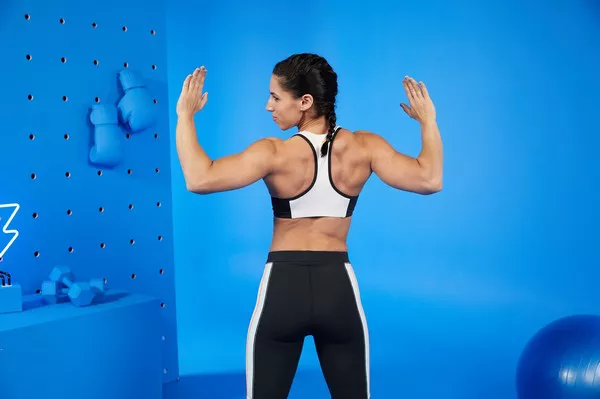When people think about fitness, they often focus on building strength, losing fat, or improving endurance. Flexibility rarely gets the spotlight. But without flexibility, your muscles and joints become stiff, your movement becomes restricted, and your risk of injury increases. Flexibility is the ability of a joint or muscle to move through its full range of motion. It’s a foundational element of health that affects everything from posture and mobility to pain and performance.
Imagine trying to tie your shoes, reach a high shelf, or twist to grab something behind you. These basic actions rely on flexibility. As you age, your muscles naturally tighten, and if you don’t stretch them regularly, your movements become shorter and less efficient. This can lead to joint stress, muscle strain, and an overall decline in physical function. Incorporating flexibility exercises into your daily routine helps maintain your body’s ability to move freely, reducing discomfort and enhancing your quality of life.
The Surprising Benefits of Being More Flexible
Improving your flexibility offers more than just feeling limber. It helps prevent injuries by allowing muscles and joints to handle physical stress more efficiently. For example, flexible hamstrings and hips can reduce the risk of lower back pain, while limber shoulders and upper back muscles help prevent neck tension. When your muscles are lengthened and elastic, they’re less likely to tear during sudden movements or exercise.
Flexibility also improves circulation. Stretching enhances blood flow to the muscles, delivering oxygen and nutrients that support recovery and performance. This is particularly important after a workout, as it helps clear out lactic acid and speeds up healing. Additionally, good flexibility leads to better posture. Tight muscles can pull your body out of alignment, causing discomfort and imbalance. Stretching helps restore symmetry and ease tension, which supports a healthy spine and reduces muscular fatigue.
What Happens When You Ignore Flexibility
Neglecting flexibility has real consequences. Stiff muscles reduce mobility, which affects your ability to perform daily activities and exercises correctly. Poor range of motion can change your posture, cause compensatory movements, and increase wear on your joints. Over time, this can result in chronic pain, joint degeneration, and decreased physical performance.
You may not notice it right away, but small signs often appear first. You might struggle to sit cross-legged, feel tension in your lower back after standing, or notice a limited reach when stretching overhead. As these restrictions accumulate, they make even normal tasks harder. What begins as minor discomfort can eventually evolve into serious issues like muscle imbalances, joint inflammation, or even injury. Flexibility isn’t just a luxury—it’s a necessity for long-term health.
Different Types of Flexibility and How They Work
There’s more to flexibility than simply being able to touch your toes. Flexibility can be categorized into different types, each with its own benefits. Static flexibility refers to the ability to hold a stretch without movement, such as a standing hamstring stretch. This type is often used in cool-down routines to improve muscle length and relaxation.
Dynamic flexibility, on the other hand, involves movement. It prepares the muscles for action and is ideal for warming up before exercise. Think of leg swings or arm circles—these mimic real-life motions and help improve functional mobility. There’s also active flexibility, where you stretch using only the strength of opposing muscles, and passive flexibility, where external force—like a partner or gravity—assists in the stretch. A well-rounded routine includes all these types, giving your body the variety it needs to move with ease and safety.
Best Practices for Safe and Effective Stretching
Many people stretch incorrectly or too aggressively, which can cause more harm than good. The key is to warm up your body before stretching. Muscles stretch more effectively when they’re slightly heated, so doing a few minutes of light cardio—like brisk walking or jumping jacks—can help prepare you for deeper stretches. Never stretch cold muscles, especially with force, as this increases the risk of pulling a tendon or tearing a muscle.
When performing flexibility exercises, go slowly and avoid bouncing. Ease into the stretch until you feel mild tension, then hold it. Bouncing or forcing the movement can trigger a reflex that makes the muscle tighten even more. Breathe deeply and consistently throughout the stretch to help your body relax and improve your range of motion. Over time, consistency is more important than intensity. Daily gentle stretching is more beneficial than occasional, intense sessions that leave you sore.
Essential Flexibility Exercises for the Whole Body
A good flexibility routine should target every major muscle group. Start with the neck and shoulders. Slowly tilt your head to each side, forward and backward, and rotate in small circles. Stretching the upper trapezius and cervical spine can relieve tension from hours of sitting or screen time. Move on to shoulder rolls and chest openers by clasping your hands behind your back and lifting your arms slightly. This helps counteract the slouched posture common in desk workers.
For your back, try the cat-cow stretch on all fours. Arch your spine up toward the ceiling, then dip it low while lifting your head. This fluid movement improves spinal mobility and reduces stiffness. In the lower body, focus on the hamstrings, quads, hips, and calves. A forward fold stretches the back of your legs, while a lunge with your back knee down targets the hip flexors. Don’t forget the calves—use a wall or step to gently stretch the Achilles tendon and calf muscles.
Flexibility Exercises You Can Do Anywhere
The beauty of flexibility training is that it doesn’t require any special equipment or location. You can stretch in your bedroom, at the office, or even during travel. A seated forward fold on the floor stretches your hamstrings, and a seated spinal twist improves back mobility. You can perform a standing quad stretch by bending one knee and pulling your foot toward your glutes, using a wall for balance if needed.
Wall-assisted stretches are great for home or gym use. Stand with your hands against a wall and step one leg back to stretch the calves. Or place one foot on the wall and lean forward to stretch the hips. Even yoga poses like downward dog, child’s pose, or cobra can be easily added to your morning routine. These movements open up the whole body and leave you feeling refreshed and more mobile throughout the day.
How Flexibility Supports Strength and Endurance
Many athletes and gym-goers underestimate the value of flexibility. They focus on lifting heavier weights or running faster but ignore mobility. This is a mistake. Flexibility directly supports strength by allowing full range of motion during lifts. For instance, a deeper squat engages more muscle fibers and improves form, but you can’t achieve that depth without flexible hips, ankles, and hamstrings.
Endurance athletes benefit from flexibility as well. Runners with tight hips or calves are more likely to suffer from overuse injuries like shin splints or plantar fasciitis. Stretching after a run keeps muscles elongated and prevents tightness from building up. Even swimmers and cyclists need flexibility to maintain efficient movement and avoid strain. In every sport, the ability to move fully and comfortably enhances both performance and recovery.
The Mental and Emotional Side of Stretching
Stretching doesn’t just benefit the body—it also calms the mind. Many flexibility exercises, especially those found in yoga or Pilates, incorporate deep breathing and mindfulness. This helps reduce stress and anxiety while promoting a sense of relaxation. Taking ten minutes to stretch at the end of the day can serve as a mental reset, helping you unwind and sleep better.
Physical tension often mirrors mental stress. Tight shoulders, clenched jaws, and stiff hips are common signs of emotional strain. By stretching regularly, you not only release that physical tension but also create a habit of checking in with your body. This connection between movement and mindfulness enhances your overall well-being and promotes a more balanced lifestyle. In this way, flexibility exercises become a tool for both physical and emotional health.
How Often Should You Do Flexibility Training?
To see lasting improvement, consistency is key. Ideally, you should stretch every day, even if only for 10 to 15 minutes. Unlike strength training, flexibility work doesn’t place high stress on the body and can be practiced frequently. You can do a full-body stretching session two to three times per week and shorter targeted sessions daily, especially for areas that feel tight.
The best time to stretch is after your muscles are warm. Post-workout is ideal, as your body is already heated and more receptive to lengthening. However, you can also stretch after a shower, before bed, or during breaks at work. The important thing is to make it part of your routine. Like brushing your teeth, stretching should become a daily habit that keeps your body functioning at its best.
Flexibility Across Different Ages and Lifestyles
Flexibility is important at every age. For children, it supports healthy growth and physical development. For adults, it helps maintain mobility, especially for those with sedentary jobs. And for older adults, flexibility can mean the difference between independence and assisted care. Stiff joints and tight muscles make balance harder and increase the risk of falls, which is a major cause of injury in seniors.
No matter your lifestyle, there’s a way to include flexibility exercises. Office workers can benefit from short movement breaks throughout the day. Athletes can use dynamic stretches to prepare for performance and static stretches to recover. Pregnant women can use gentle flexibility work to reduce muscle tension and prepare for childbirth. Everyone, regardless of fitness level, can stretch safely and see improvements over time.
Conclusion
Flexibility is one of the most overlooked pillars of fitness, yet it’s essential to your health, comfort, and performance. It allows your body to move freely, prevents injury, and reduces tension in both muscles and the mind. Flexibility training doesn’t require equipment or special skills—just a little time, patience, and consistency. Whether you’re an athlete, a desk worker, or simply someone who wants to feel better in their own body, stretching daily can transform how you move and live.
Don’t wait until stiffness sets in or pain appears. Start small, stay consistent, and gradually explore the full range of your body’s motion. Your joints will move more smoothly, your posture will improve, and your muscles will thank you. Flexibility isn’t just about touching your toes—it’s about unlocking the full potential of your body. And the best time to start is now.
Related Topics



































